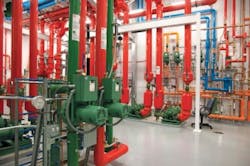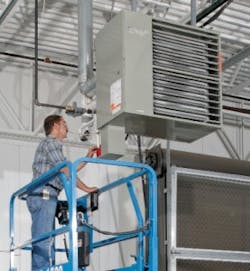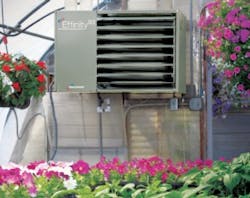Commercial hydronic systems are being scrutinized by experts nationwide. Though the close inspection of operation and efficiency likely won’t inspire a Mechanical Systems CSI television series, there’s certainly no lack of interest by commercial system pros. It’s the sort of shake-up that invariably happens when new technology avails a better way of doing things.
Many new developments have combined to broadly improve system efficiency—impacting virtually all facets of the connected system—from ease of installation, pumping strategy, operational efficiency, to performance. New technology is the core of an exciting, burgeoning paradigm shift.
Why all the attention? Because the benefits are so numerous, beginning with greatly enhanced energy efficiency, to improved system performance and expanded equipment life cycles. Some experts believe that what we’re seeing now is the broad application of technology whose time has finally come.
What’s refreshing is the objectivity of the movement. It’s not about ECM (Electronically Commutated Motors that use DC power) that offer small, though cumulative advantages in energy use, or esoteric pump impeller design, or high-tech pipe lining. It’s all about the aggregate impact of advancements that smartly contribute to a building’s overall energy efficiency, and with unprecedented effectiveness.
Pumps
Pumps that learn a system’s needs, entirely on their own; boilers that conduct system pumping to beat the band; volume water heaters designed for extreme efficiency, and self-monitoring, predictive combustion controls: These are among the many parts and pieces that combine to illustrate trends in the hydronic industry today. For those of us who watch for trends in the industry, we see that advances like these frequently are at the cutting, exploratory edge of an always-evolving landscape.
Smart pumping is one of those fast-evolving trends. A fine example are new, commercial self-sensing pumps that avail “systems integration”—something “system designers and engineers have worked toward for decades,” says Richard Medairos, P.E., senior systems engineer and director of commercial training at Cranston, RI-based Taco Inc. Medairos has spent more than 30 years in the hydronics and commercial building design industries, most of them as an independent consulting engineer.
A facility maintenance manager checks operation of a Modine Effinity93 unit heater.
Medairos explains that one of the latest advancements has been the expanding reach of sensorless pumps. With sensorless pumping, there are no holes in pipes for tubes or taps connecting remote differential sensors together with the pump. Also, self-sensing pump system design offers the advantages of greater accuracy for variable flow, higher energy efficiency, and improved system stability.
“To make the primary equipment more efficient, we need to control the Delta-T and also to match capacity with the load,” says Medairos. “That’s where variable speed pumping makes its greatest contribution.”
When there’s equilibrium between a system’s capacity and load, and optimal Delta-T, maximum efficiency is attained. Medairos refers to it as a symbiotic relationship between the system and primary equipment. “To achieve greatest performance, they need each other in a harmonious fit,” he says. “With new and responsive pump technology, we can now strive for optimal system balance.”
A key driver is the rapidly growing use of variable speed pumps in the hydronics industry. There are substantial benefits:
- If the load varies, there’s a corresponding reduction in pump speed; with a drop in pump speed, there’s a significant reduction in pump power (at half speed, only 1/8 of the full horsepower is required; or, by reducing speed to 1/3, power is reduced to 1/27th).
- With variable speed, power is gradually increased; soft-starts are beneficial to the motor, pump, and system components.
- By reducing pump speed to match the load, energy is saved and equipment longevity is greatly improved.
In the opinion of many industry experts today—considering all facets of the system working in harmony—we’ve now arrived at a place and time that permits the type of systems integration to which Medairos refers.
Variable Speed Pumping = Variable Flow
David Peacock, Eastern TN sales manager for Atlanta-based Peacock Sales, and Taco’s Bryan Payne, Southeast commercial regional manager, both affirm that the trend toward the use of variable drives for all pumps, both constant and variable flow, is a seismic one. They say that the trend is the most powerful each has seen in their 25+ years in the trade.
According to Payne, the application of variable frequency drives (VFDs) to constant speed pumps is now the fastest growing segment of the commercial pumping industry, a trend that improves the performance and efficiency of both large domestic water and hydronic heating and cooling systems.
“The benefits are dramatic,” says Payne. “Fortunately, the cost of drives is decreasing, and the technology offered by drive manufacturers seems to improve daily.”
The advantages to retrofitting constant-speed pumps with VFDs include
- greater energy efficiency,
- more precise flow control,
- soft-starting and stopping of motors to prolong pump life,
- the integration of BMS communication,
- better balancing with speed control versus imparting “false” head, and
- installing the ability to easily adjust flow to re-rate energy plants when system flow gets out of balance or experiences reduced Delta T.
Peacock points to other advantages: variable speed technology allows building maintenance pros to sense dangerous conditions for motors, or problems with pumps, and also can signal a building management system if there are problems, triggering standby equipment to start for redundancy and backup.
“Variable speed drives do all these things while saving energy and increasing equipment lifespan,” adds Peacock.
Boilers With On-Board Controls
At last year’s AHR Expo—considered by many to be the industry’s Super Bowl—a boiler with on-board pump controls was an attention-getter. “Combining a 95% thermal efficiency modulating-condensing boiler with an advanced pump control that seamlessly matches boiler firing rate to pump flow makes great sense,” says Chuck O’Donnell, marketing director for Laars Heating Systems Co., based in Rochester, NH. “Combining the boiler and pump controls within the box allows us to offer a true system, capable of independent, smart operation while reducing boiler pumping costs by up to 70%.”
According to O’Donnell, fully modulating and condensing boilers do an excellent job of maximizing both boiler electrical (blower) and combustion efficiency. However, the third component to installed boiler efficiency that is often overlooked: the boiler pump. “A large savings opportunity exists by using a variable speed boiler pump that is load matched to a modulating boiler’s combustion system,” he says.
A Modine Effinity93 unit heater installed in a greenhouse
After many years of development, Laars introduced its VARI-PRIME pump control as the answer to maximizing boiler pump savings. Total boiler installed efficiency is greatly enhanced by load matching boiler and pump operation. The control system also protects the boiler’s most essential component—the heat exchanger—by ensuring the variable speed boiler pump remains in phase with the boiler’s combustion modulation.
In traditional boiler installations, boiler pumps are sized to match the flow required for boilers firing at full rate. In that scenario, pumps will run at full speed every time the boilers fire, regardless of the actual flow required by the boilers. A VARI-PRIME installation, in conjunction with a variable speed pump, tracks the heating profile curve to dramatically reduce the electrical usage of the boiler pump. That’s because a variable speed pump’s power consumption can drop by as much as 50% with only a 20% reduction in speed.
O’Donnell explained that the VARI-PRIME control comes standard on Laars MagnaTherm condensing modulating boilers and is available as an optional package on the company’s NeoTherm condensing boiler line.
“I see real advantage in providing on-board control functionality that balances gas flow, air flow, and now even water flow to optimize boiler efficiency through immediate response to load changes,” says Mike Haigh, government/contractor sales manager for Federal Corp., an Oklahoma City-based manufacturer’s rep and visitor at the AHR Expo booth.
“I’m delighted to see that ‘state-of-the-art’ is always-evolving. The dramatic efficiency improvements developed by Laars enhance both boiler efficiency, and overall system efficiency. At the AHR Expo, where I was first introduced to VARI-PRIME, we can see and interact with the systems on the show floor. These quickly translate into advantages—chiefly reduced operational and service costs—for building owners and developers. That’s the sweet spot.
Diversification, Greater Efficiency
The US Department of Energy (DOE) presents the need for efficiency improvements as very substantial. DOE estimates that heating residential and commercial buildings uses 20 to 25% of the total energy consumed in the US each year. It’s with this in mind that some leading manufacturers have strategically diversified their operations.
Ambler, PA-based Bradford White chose to broadly enhance its product line with the rollout of new, gas-fired hydronic and volume water heater equipment at last year’s AHR Expo, substantially adding to its existing residential and commercial water heater lines.
“DOE has made it very apparent that heating efficiency of buildings will be a major thrust in years to come, though with our expansion into heating systems, we also see the move as a way to improve outreach among buyers and specifiers within an ever-changing market,” says Carl Pinto, director of marketing for the manufacturer.
Pinto adds that, “At the [AHR] Expo, show attendees—and, later, a majority of industry experts and loyal Bradford White installers—have been very receptive” to their entry into the hydronic and volume water heater realm.
The company’s new modulating-condensing, low NOx, boiler and volume water heater lines include both residential and commercial models with inputs from 80,000 to 2.4 million BTU per hour, with efficiencies up to 98%.
“Of course, there are key advantages with a broader product line—availing our entry into new markets and installation opportunities,” continued Pinto. “But we also wanted to be sure that, when the new products were rolled out, we did so after rigorous research and product development, with equipment safety and high efficiency as goals that had to be achieved with no compromise.
“The forces of an ever-greening world—with DOE and USGBC, among many others, leading the call for greater operational efficiency, provide an excellent growth opportunity for Bradford White,” says Pinto.
Collaboration for Combustion
AERCO’s “O2 Trim” system is an intelligent combustion control system that helps meet and surpass the efficiency needs of today’s energy systems.
The Dioxide Trim is an innovative new feature for the company’s combustion controls. “By directly monitoring the O2 content of flue gases, the system ensures optimal air/fuel ratios for maximum combustion efficiency, stability and thus reliability,” says Peter Rimassa, the company’s director of product solutions and training.
In the event O2 levels fall out of the specified range due to gas pressure fluctuations, air temperature density changes, gas heating value, and such, the system adjusts blower speed voltage to bring oxygen levels back to the specified range (and consequently optimal air/fuel ratio).
“This capability offers flexibility and peace of mind in the event of combustion parameters changes (as indicated previously) while ensuring the highest combustion efficiencies in a heating season,” states Nery D. Hernandez, AERCO’s product solutions manager for commercial boilers.
In addition to efficiency and flexibility, the system aids in providing uptime reliability since it notifies the end user of any combustion system errors or excessive trimming, which may be indicative of other system issues. This allows the end user to take preventative measures, if necessary—an advantage over expensive reactive measures that may lead to more costly downtime.
Innovation Tied to Trends
Use of hydronic-based comfort systems in commercial-industrial facilities in the US will continue to be a preferred option for the high energy-efficiency and superior indoor comfort they provide. Advances in boiler and pumping technologies like condensing boilers, cascade packages, variable speed drives on pumps, use of radiant heating/cooling systems and enhanced smart controls help to reduce energy use and the cost of operating mechanical systems.
On the heat generating side of the HVAC equation, Bosch Thermotechnology was an early developer of gas condensing boiler technology and currently offers a range of low and high mass commercial boilers under its Bosch and Buderus brands.
A popular Buderus condensing and modulating wall-hung boiler, with sizes up to 330 MBH, offers performance efficiencies up to 93% AFUE in multi-unit cascade packages of up to eight boilers. With a minimal footprint on the floor stand or on a wall, the GB162 boiler can be used in new construction and especially in mixed plant situations where an existing central boiler is retained and overall plant efficiencies are improved by use of supporting GB162 cascades.
Controlling multiple boiler operations with building management systems is being assisted by BACnet/Modbus linked control devices like the new Bosch Heatronic 4000 boiler control, which produces and maintains a set target temperature to enhance energy efficiency, system control and overall boiler performance. It can be used with up to four boilers, condensing or non-condensing, and in mixed plants employing a combination of both boiler types.
Biomass, Too
In Europe, biomass boilers are in continuous development and gaining acceptance in the marketplace. With more and more people encouraged to consider reducing their own carbon footprint, international companies like Bosch are working to reduce their carbon emissions. With this in mind, biomass boilers can burn wood chips or pellets and can be as advanced as CHP (combined heat and power) units. CHP units provide simultaneous production of heat and electricity using biomass fuels to greatly reduce the environmental impact to a fraction of the carbon emissions of fossil fuels.
Self-Balancing Pump Control System
Taco’s LoadMatch—tied inseparably to market demand for smart, whole system efficiency—is a unique blend of two technologies; one new, one old. Single-pipe distribution and primary-secondary pumping are proven technologies that—as part of a LoadMatch system—are enhanced by the use of maintenance-free, wet rotor circulators.
The primary distribution system is a single-pipe loop. Secondary distribution system is a relatively tiny, decoupled loop for each terminal unit—whether it’s a heat pump, a fan coil unit or chilled beam, etc. Small, low-kilowatt LoadMatch circulators provide the specified flow to each unit, eliminating the need for control valves and most balancing valves.
The system is self-balancing, which reduces many startup, commissioning, and operational problems because all zones are completely independent of each other and get their required amount of flow at all times.
In addition to the energy savings typical with hydronic systems, LoadMatch reduces head loss (essentially, resistance within the piped system) by eliminating many control and balancing valves, as well as some pipe. The result leads to a reduction in primary pump size by up to 50%, according to Jeff Pitcairn, Taco’s commercial regional manager.
Efficiency, Unexpectedly
Ah, the lowly unit heater. All too often regarded as relic from a mid-80s AFUE bygone era (begrudgingly necessary to meet occasional, rudimentary heating needs), these “space heaters” have a new, high-efficiency champion, eager to take a more prominent role on the HVAC stage.
Modine chose to develop a “David” to do battle in this world of sophisticated heating system Goliaths. Bucking the trends, Racine, WI-based Modine Manufacturing developed a 93% unit heater with input ratings from 55,000 to 310,000 BTU per hour. Called the Effinity93, the systems come in 10 model sizes, including the four smallest models which are residentially certified.
At 93% minimum thermal efficiency, the units are the most efficient gas-fired unit heaters available today. Covering a wide range of heating demands, these clever systems open up an entirely new market where high efficiency is called for, yet where installations permit a more utilitarian approach.
Modine accomplished the higher efficiency range with a stainless steel secondary heat exchanger specifically designed to withstand acidic combustion condensate.
“We’re frequently asked why these gas-fired systems are so closely associated with hydronic technology,” says Ray Schaffart, the company’s marketing and sales support manager.
Most unit heaters are hydronic—they started out as a way of extending the reach of hydronic systems decades ago. So, by association, when most heating professionals—and especially, most hydronic heating pros—hear “unit heaters” or “space heaters,” they think of the wall—or ceiling-hung hydronic units that attach to, or extend, a hydronic heating system.”
Much newer to the scene are gas-fired heaters that mimic the style and capability, and tightly defined space heating function of their hydronic brethren (which receive hot water, thrust into a coil, with BTUs that are moved through the air by a fan—again, very similar to the function of the new gas-fired units). “I’ll also point out that it’s often the hydronic pro that installs these, not the HVAC guys, because of the close association between the hydronic unit heaters and the newer units,” adds Schaffart.
These new—i.e., trend-setting—systems not only join that new group, also but offer an even newer function/advantage in their ability to provide 93% efficiency. It’s quite an accomplishment.
Hybrid Systems Education
“One of the biggest advancements we seek to be involved with at Cleaver-Brooks, through education, is for facility managers and building owners to gain a greater understanding about how condensing technology works, its limitations, and proper control method,” says Brian Huibregtse, product engineer. The end results, says Huibregtse, are efficiency gains, higher equipment reliability, and happier end users.
“There is indeed a trend toward hybrid solutions for hydronic heating systems, versus the use of 100% condensing boilers—both for new install and retrofit situations,” adds the manufacturer’s Sean Lobdell, product manager.
“Hybrid hydronic system solutions are those that integrate condensing and non-condensing boilers as well as utilizing steam boilers with steam-to-hot water heat exchangers to provide backup and redundancy for systems,” says Lobdell. “The reasons for this hybrid approach are reduced equipment and installation cost, backup fuel oil requirements, and the advantage of retrofitting existing systems at reduced cost for faster payback.”
Leave it to industrious, restless US manufacturers. Their best efforts, by design, improve yours, too.
John Vastyan is a journalist whose work focuses on the plumbing and mechanical, HVAC, geothermal, solar, and radiant heat industries.




